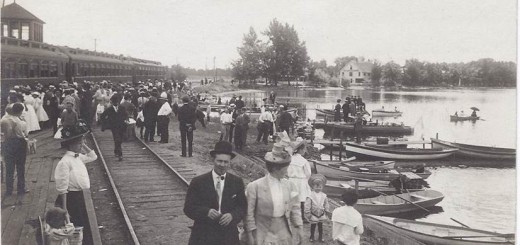Early Travel and Settlement around Lakeland
on the Chain of Lakes
By Grace Shackman
In 1907, Eli Moore, a Pinckney resident, wrote that “the change of scenery from lake to river and river to lake was beautiful beyond description to a lover of nature,” recalling an 1877 rowboat trip he took from Portage Lake where he was camping, to Zukey Lake. He also mentioned on that trip that he saw very few, if any, cottages on the lakes but did see an occasional tent. This should not have been too surprising as most of the early settlers in the area were farmers who did not consider having a lake on their property an advantage as neither the lakes nor their marshy shores could be planted. The pioneers who did end up with lakefront acreage made due by cutting wild marsh hay for feed before they had time to put in better crops and in winter cutting and storing lake ice to sell. At that time roads were just Indian trails or at best wagon trails, so lake access was difficult for those interested in traveling to the area.
Access improved after 1878, when the Ann Arbor Railroad reached Whitmore Lake and Lakeland (the village on the north end of Zukey Lake), which opened up these two communities for vacationers from the Ann Arbor and Toledo areas and beyond. Train passengers could stay at hotels or cottages or come just for the day. Daily traffic got so busy that during the interurban railroad bubble at the turn of the twentieth century, there was talk of laying interurban tracks from Lakeland to Ann Arbor; a competitive threat the Ann Arbor Railroad blocked by running a gasoline-powered McKeen motor car on its own tracks. Nicknamed “the ping-pong,” it ran back and forth between Ann Arbor and Lakeland eight times a day from 1911 until 1924.
which opened up these two communities for vacationers from the Ann Arbor and Toledo areas and beyond. Train passengers could stay at hotels or cottages or come just for the day. Daily traffic got so busy that during the interurban railroad bubble at the turn of the twentieth century, there was talk of laying interurban tracks from Lakeland to Ann Arbor; a competitive threat the Ann Arbor Railroad blocked by running a gasoline-powered McKeen motor car on its own tracks. Nicknamed “the ping-pong,” it ran back and forth between Ann Arbor and Lakeland eight times a day from 1911 until 1924.
Once people got to Zukey Lake, they could access the rest of the chain of lakes by boat. Steam-powered passenger boats began running in 1897. The first steamer was named the “Prudence Potts” after the daughter of owner J.W. Potts.
When internal combustion engines became reliable enough, people quickly switched to them because they didn’t blow up like steam boilers could. UM professor of physics, Karl Guthe, and his wife, Belle, used a “motor” launch to bring visitors to their cottage on Strawberry Lake. They also used the boat to pick up groceries at the store in Lakeland.
If motor launches were the lakes’ equivalent of limousines, then rowboats were the taxis and rental cars. Rowboat owners met all the trains and could take people directly to their cottages. The Waters’ Pavilion Resort in Lakeland promised “motor boats, row boats and canoes for all,” while Fred Imus, also of Lakeland, offered motor boat livery services as well as boats for sale.
People who owned cottages often remained there all summer (at least the mother and children did), with the father commuting evenings and weekends. Families who didn’t own a cottage could rent one and follow the same pattern for part of the summer.
Lakeland’s biggest attraction was, and still is, the Zukey Lake Tavern, which opened when Prohibition ended. The original owners, the Girald brothers, used to take their motorboat down the Chain of Lakes, picking up passengers and bringing them back to the tavern. Many customers still come to the tavern by boat today.
After World War II, construction of I-94 and US-23 made it easier to live on the lakes while commuting to work in Ann Arbor and beyond. Owners began winterizing their summer cottages or totally replacing them. Another big step toward year-round living came in the 1980’s when sewage system installation began.